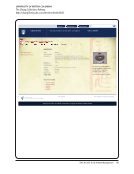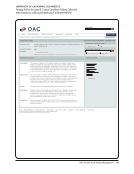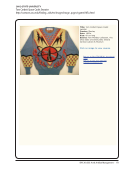SPEC Kit 333: Art &Artifact Management · 51
Challenge 1 Challenge 2 Challenge 3
Storage of strangely shaped objects. Helping researchers understand that
art objects and artifacts are included in
archival collections.
Storage space. Lack of staff trained specifically in
describing and conserving art.
Appropriate public interface.
Storage space. Preservation/conservation. Difficulty describing art/artifacts.
Storage, conservation, and display issues
in a facility build for book &manuscript
collection storage and use.
Ownership issues, a higher proportion
of are art collection appears to be
undocumented, making it difficult to
assume clear ownership.
Outreach and marketing: if we see value
in keeping /collecting art and artifacts,
what do we *do* with this materials to
justify that effort.
The finding number system that we
use for our art objects is based on the
location of the object, so it is difficult
and resource-intensive to physically
reorganize our storage or move objects.
Artifact storage is a challenge because of
varying sizes and shapes of the objects.
The description of artifacts in finding
aids is a challenge because they cannot
always be found easily.
The UF Latin American Collection is
mainly a circulating academic library
specializing in books and serials on Latin
America. We do not have experience
with this kind of museum collection and
are trying to learn the best techniques for
management.
Space is an issue, especially as off-
campus storage is increasingly important
and this makes access difficult for
processing. Also, because of space (and
staffing) issues at UF, the collection
was more accessible to its donors/
supporters when housed at the now-
defunct Panama Canal Museum (PCM) in
Seminole.
The work done by PCM volunteers to
accession objects is very admirable. We
are now looking at their inventory from
the perspective of wanting to make
it useful as an archival finding aid for
researchers, and trying to negotiate that
change. For example, a variety of terms
have been used to describe objects, and
some parts of the collection have been
described more thoroughly than others.
Time: not enough of it. Lack of training to work with art and
artifacts.
Lack of appropriate storage.
To convey their unique qualities to users.
Volume is an issue, for examples 2 million
photographs and thousands of items of
ephemera.
Intellectual property issues, including
rights to reproduce for publication or for
online finding aids.
Insufficient resources for preservation,
arrangement, and description of analog
materials or for presentation through
exhibition or publication.
We are really not trained or well set up to
manage arts objects (things are slightly
better for artifacts). For instance we feel
like much of our storage of these items
tends more to the “make do” than what
is preferred.
We have no conservation staff to treat art
objects and artifacts, so some condition
issues are never addressed adequately.
We’re chronically understaffed so usually
working with these types of collections
is added on to someone’s already too full
plate.
We do not have adequate storage
facilities for many types of artwork and
artifacts.
We do not have a preservation budget
or personnel to adequately preserve and
maintain artwork and artifacts.
We often question the historical and
research value of some of these materials
(particularly artifacts), but donors and
researches often assume they have
intrinsic value as objects.
Challenge 1 Challenge 2 Challenge 3
Storage of strangely shaped objects. Helping researchers understand that
art objects and artifacts are included in
archival collections.
Storage space. Lack of staff trained specifically in
describing and conserving art.
Appropriate public interface.
Storage space. Preservation/conservation. Difficulty describing art/artifacts.
Storage, conservation, and display issues
in a facility build for book &manuscript
collection storage and use.
Ownership issues, a higher proportion
of are art collection appears to be
undocumented, making it difficult to
assume clear ownership.
Outreach and marketing: if we see value
in keeping /collecting art and artifacts,
what do we *do* with this materials to
justify that effort.
The finding number system that we
use for our art objects is based on the
location of the object, so it is difficult
and resource-intensive to physically
reorganize our storage or move objects.
Artifact storage is a challenge because of
varying sizes and shapes of the objects.
The description of artifacts in finding
aids is a challenge because they cannot
always be found easily.
The UF Latin American Collection is
mainly a circulating academic library
specializing in books and serials on Latin
America. We do not have experience
with this kind of museum collection and
are trying to learn the best techniques for
management.
Space is an issue, especially as off-
campus storage is increasingly important
and this makes access difficult for
processing. Also, because of space (and
staffing) issues at UF, the collection
was more accessible to its donors/
supporters when housed at the now-
defunct Panama Canal Museum (PCM) in
Seminole.
The work done by PCM volunteers to
accession objects is very admirable. We
are now looking at their inventory from
the perspective of wanting to make
it useful as an archival finding aid for
researchers, and trying to negotiate that
change. For example, a variety of terms
have been used to describe objects, and
some parts of the collection have been
described more thoroughly than others.
Time: not enough of it. Lack of training to work with art and
artifacts.
Lack of appropriate storage.
To convey their unique qualities to users.
Volume is an issue, for examples 2 million
photographs and thousands of items of
ephemera.
Intellectual property issues, including
rights to reproduce for publication or for
online finding aids.
Insufficient resources for preservation,
arrangement, and description of analog
materials or for presentation through
exhibition or publication.
We are really not trained or well set up to
manage arts objects (things are slightly
better for artifacts). For instance we feel
like much of our storage of these items
tends more to the “make do” than what
is preferred.
We have no conservation staff to treat art
objects and artifacts, so some condition
issues are never addressed adequately.
We’re chronically understaffed so usually
working with these types of collections
is added on to someone’s already too full
plate.
We do not have adequate storage
facilities for many types of artwork and
artifacts.
We do not have a preservation budget
or personnel to adequately preserve and
maintain artwork and artifacts.
We often question the historical and
research value of some of these materials
(particularly artifacts), but donors and
researches often assume they have
intrinsic value as objects.


















































































































































































